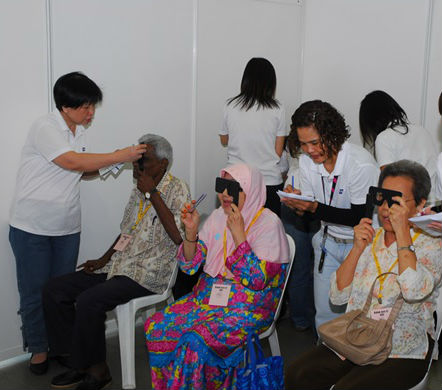Low vision in almost half of the Malay elderly population
SERI’s first study looking at eye diseases affecting Malays found high prevalence of hypertension and diabetes.
BY: Eleanor Yap
The Singapore Eye Research Institute (SERI) has been analysing the eye diseases affecting the various races in Singapore (they are in the midst of analysing the data on the Chinese elderly population). The first they analysed were the Malays and they found some surprising data including the high prevalence of hypertension and diabetes, and half were suffering from low vision.
Ageless Online speaks to Prof Ecosse Lamoureux from the SERI’s Epidemiology Group to find out about the Malay study that the Institute did and some early predictions with the Chinese group:
I understand there was a two-year study from 2004 to 2006 of 3,200 Malays aged 40 to 80 looking at eye diseases. Can you share some of the key findings?
Hypertension was assessed using systolic blood pressure of ≥140 mmHg, diastolic blood pressure ≥90 mmHg and/or a physician diagnosis of hypertension. Similarly a diagnosis of diabetes was determined on non-fasting glucose levels ≥200mg/dl (11.1mmol/l), a physician diagnosis of diabetes, and/or the use of diabetic medications.
We found that prevalence rates of hypertension and diabetes among the Malays were almost 70 percent and 25 percent, respectively. These values were higher than other developed countries like Japan, Australia, UK, and US.
For example, for hypertension, when compared to Singaporean Malays, the prevalence in the adult population of Malaysia ranges from 14 percent in the rural areas to 41 percent in a national survey. Our study was not designed to specifically look at the risk factors associated with these two conditions but from our collected data and also from other studies in Singapore, we understand that contributing factors include family history, lifestyle (i.e. lack of exercise, poor diet and smoking), lack of awareness, poor compliance to regular screening and disease management, illiteracy, low education, obesity and low income.
I understand another finding was that half of the Malay population had low vision. What are the figures and why does this surprise you?
Low vision or vision impairment could be considered as the measurement of presenting distance vision less than 6/12 in the better-seeing eye. We found that almost half (46.5 percent, 1,516) of our Malay population had some form of low vision in one or both eyes. Almost 20 percent (645) had low vision in both eyes.
These figures are certainly high and quite surprising as almost half of these participants with low vision could have their impairment improved with glasses. So raising awareness, education, access to care and affordability are relevant issues to improve vision impairment in Singaporean Malays.
Any distinction between women and men?
Our study found that women had a slightly higher prevalence of bilateral visual impairment than men even after correction. This could be due to the fact that women tend to live longer, do not adhere to regular eye examinations, have limited access to eyecare, or have lower eye specific literacy compared to men.
What are some common eye conditions that affect the elderly Malay population?
The most common eye conditions in the Malay population in Singapore are cataract, uncorrected refractive error, diabetic retinopathy, glaucoma and age-related macular degeneration (AMD).
You have already analysed the Indian population and are still analysing the Chinese data. Are you able to give us some predictions comparing those already of the Malay population?
It appears that the Malays and Indians have similar rates of vision impairment and eye diseases. Rates of hypertension and diabetes appear to also be similar. Our early analyses suggest that the Chinese group may have lower rates compared to the other two ethnic groups. Precise figures are currently available but could be in the range of 30 to 50 percent.
With these findings, what should the Singapore National Eye Centre (SNEC) or even the Government do to help this population?
Implement national campaigns and messages to increase awareness, knowledge and eye-specific health literacy regarding vision impairment and eye diseases; improve access to early and regular screening of eye diseases; and consider novel models of eyecare particularly for those who are economically- and educationally-disadvantaged. India, among other countries, has implemented several projects to provide free (or at a very low cost) eyecare to those at the lower end of the economic ladder.
Can you give three pieces of advice to the Malay elderly and how they can take care of their eyes?
- Get your eyes regularly tested if you are aged 40 and above; and/or have a family history of eye diseases, diabetes and hypertension.
- Always follow the treatment and advice provided to you by your eye doctor.
- Avoid smoking and if you have diabetes, ensure that you maintain your blood sugar in the recommended range and have a healthy lifestyle.


0 Comments